Abstract
Fructose transport in lactococci is mediated by two phosphotransferase systems (PTS). The constitutive mannose PTS has a broad specificity and may be used for uptake of fructose with a fructose saturation constant (KFru) of 0.89 mM, giving intracellular fructose 6-phosphate. The inducible fructose PTS has a very small saturation constant (KFru, <17 μM), and the fructose 1-phosphate produced enters the Embden-Meyerhof-Parnas (EMP) pathway as fructose 1,6-diphosphate. Growth in batch cultures of Lactococcus lactis subsp. cremoris FD1 in a yeast extract medium with fructose as the only sugar is poor both with respect to specific growth rate and biomass yield, whereas the specific lactic acid production rate is higher than those in similar fermentations on other sugars metabolized via the EMP pathway, e.g., glucose. In fructose-limited chemostat cultures, the biomass concentration exhibits a strong correlation with the dilution rate, and starting a continuous culture at the end of a batch fermentation leads to large and persistent oscillations in the biomass concentration and specific lactic acid production rate. Two proposed mechanisms underlying this strange growth pattern follow. (i) Fructose transported via the fructose PTS cannot be converted into essential biomass precursors (glucose 6-phosphate or fructose 6-phosphate), because L. lactis subsp. cremoris FD1 is devoid of fructose 1,6-diphosphatase activity. (ii) The fructose PTS apparently produces a metabolite (presumably fructose 1-phosphate) which exerts catabolite repression of both mannose PTS and lactose PTS. Since the repressed mannose PTS and lactose PTS are shown to have identical maximum molar transport rates, the results indicate that it is the general PTS proteins which are repressed.
Full text
PDF
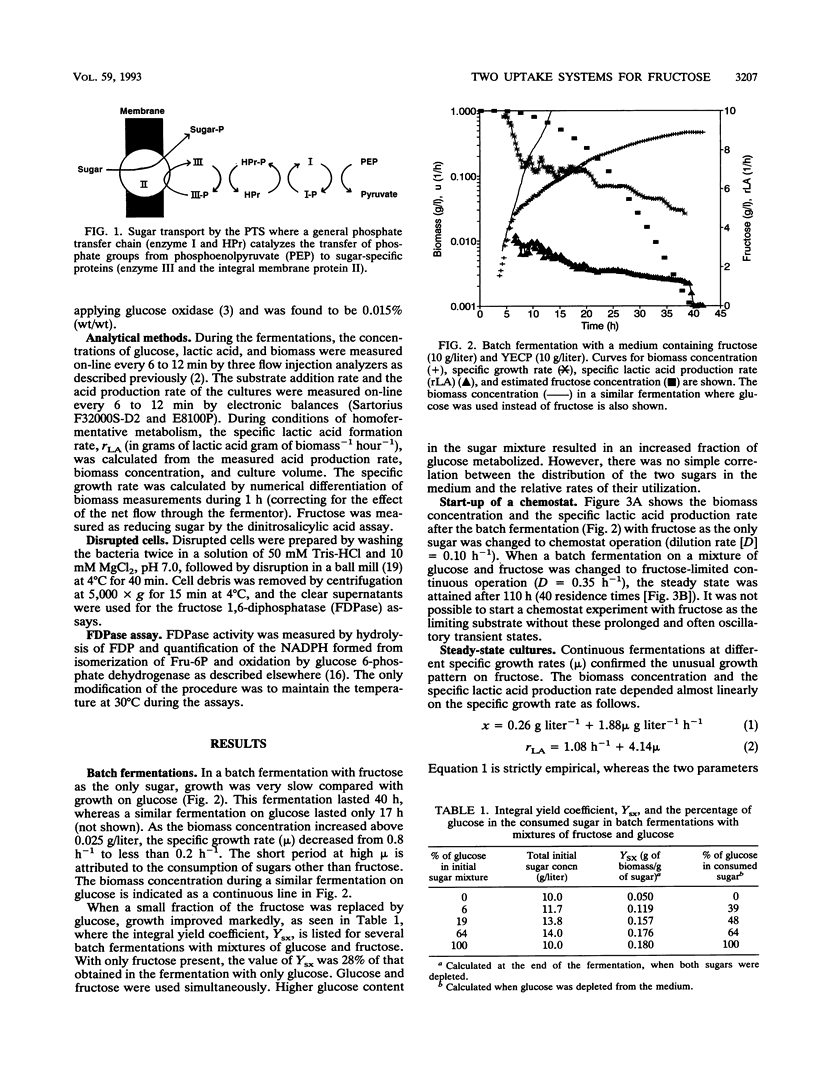
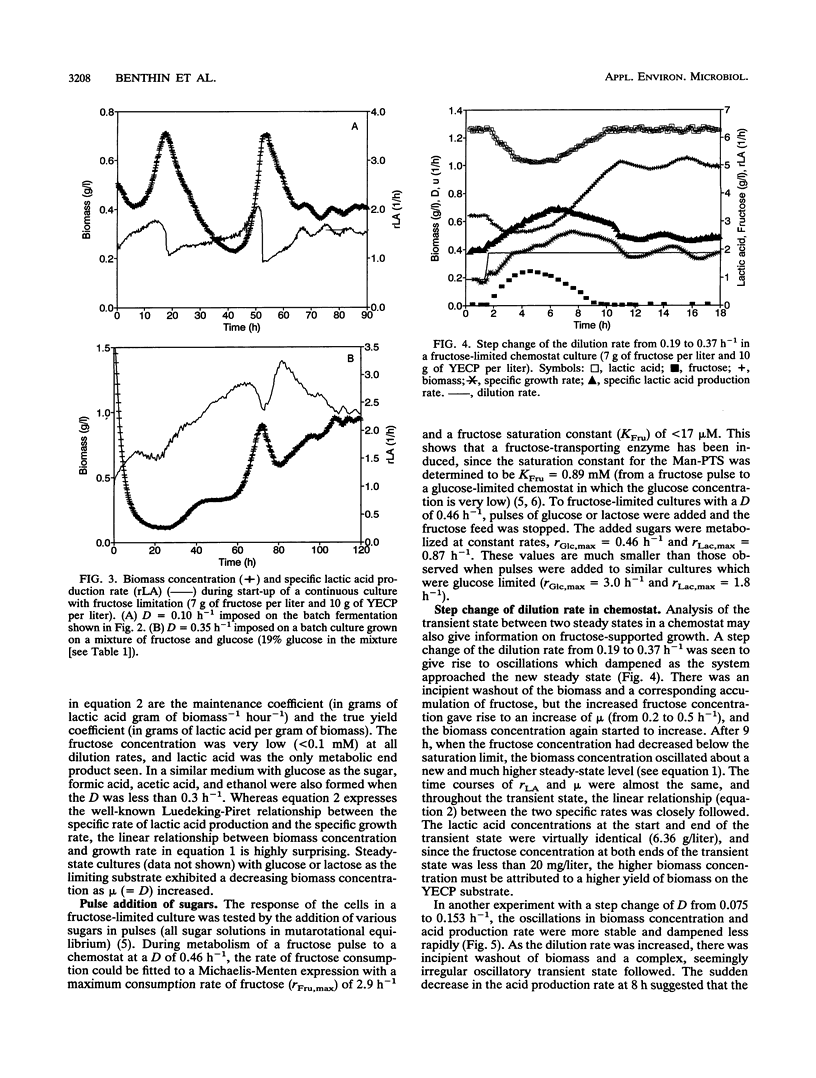
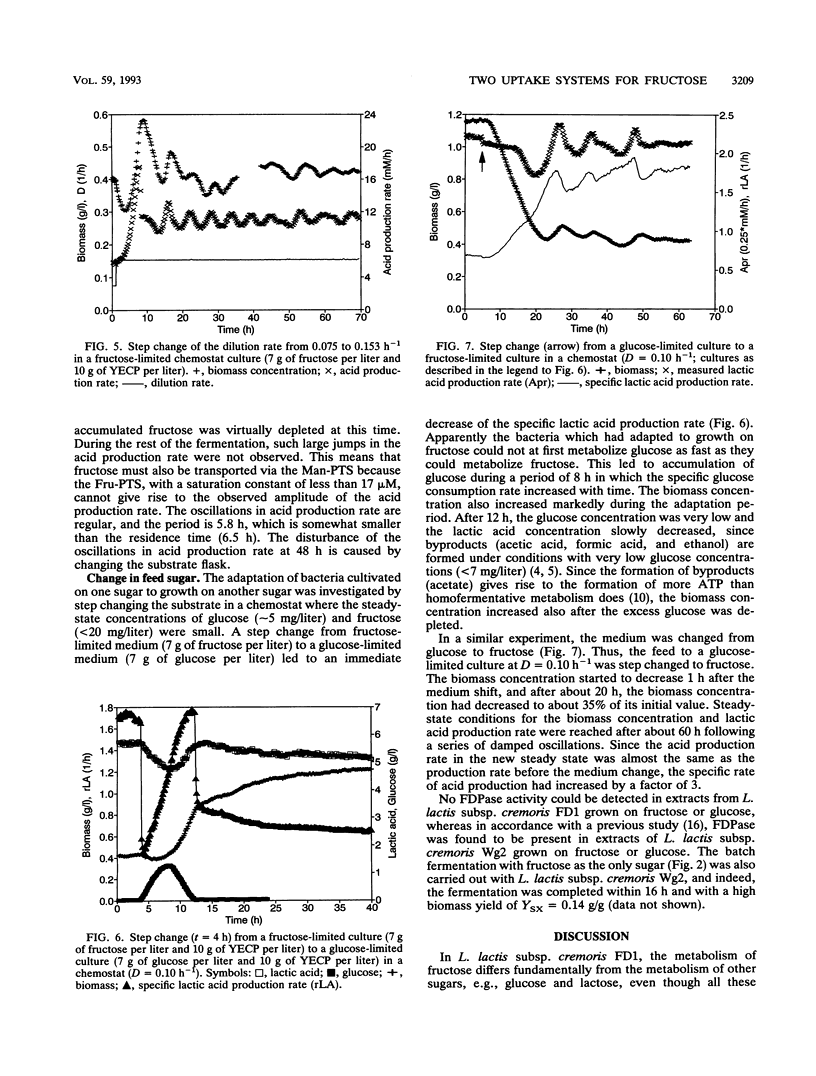
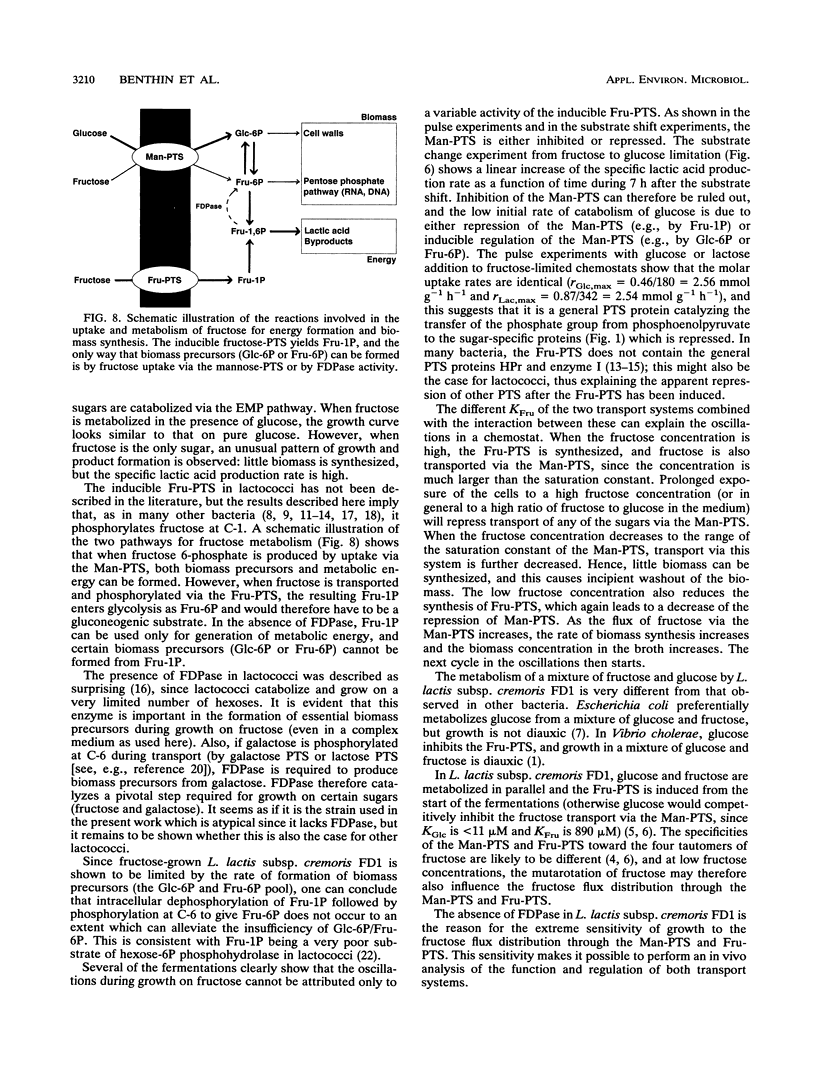
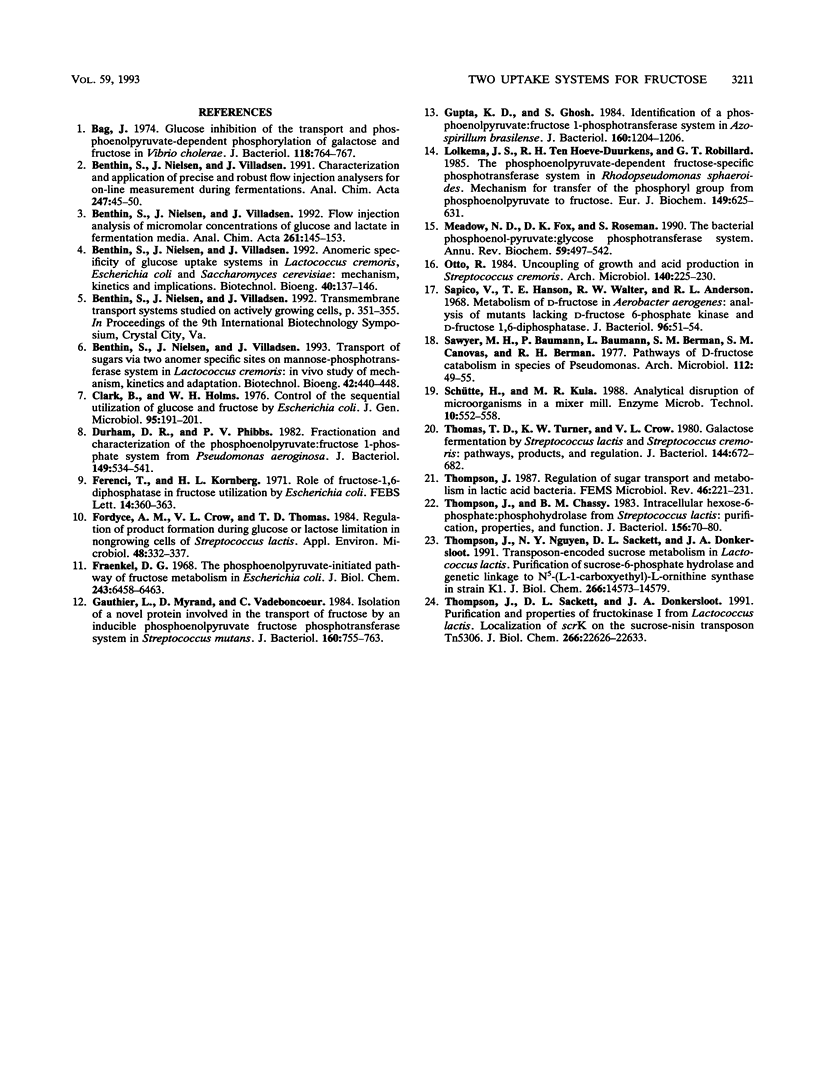
Selected References
These references are in PubMed. This may not be the complete list of references from this article.
- Bag J. Glucose inhibition of the transport and phosphoenolpyruvate-dependent phosphorylation of galactose and fructose in Vibrio cholerae. J Bacteriol. 1974 May;118(2):764–767. doi: 10.1128/jb.118.2.764-767.1974. [DOI] [PMC free article] [PubMed] [Google Scholar]
- Clark B., Holms W. H. Control of the sequential utilization of glucose and fructose by Escherichia coli. J Gen Microbiol. 1976 Aug;96(2):191–201. doi: 10.1099/00221287-95-2-191. [DOI] [PubMed] [Google Scholar]
- Durham D. R., Phibbs P. V., Jr Fractionation and characterization of the phosphoenolpyruvate: fructose 1-phosphotransferase system from Pseudomonas aeruginosa. J Bacteriol. 1982 Feb;149(2):534–541. doi: 10.1128/jb.149.2.534-541.1982. [DOI] [PMC free article] [PubMed] [Google Scholar]
- Ferenci T., Kornberg H. L. Role of fructose-1,6-diphosphatase in fructose utilization by Escherichia coli. FEBS Lett. 1971 May 20;14(5):360–363. doi: 10.1016/0014-5793(71)80301-0. [DOI] [PubMed] [Google Scholar]
- Fordyce A. M., Crow V. L., Thomas T. D. Regulation of product formation during glucose or lactose limitation in nongrowing cells of Streptococcus lactis. Appl Environ Microbiol. 1984 Aug;48(2):332–337. doi: 10.1128/aem.48.2.332-337.1984. [DOI] [PMC free article] [PubMed] [Google Scholar]
- Fraenkel D. G. The phosphoenolpyruvate-initiated pathway of fructose metabolism in Escherichia coli. J Biol Chem. 1968 Dec 25;243(24):6458–6463. [PubMed] [Google Scholar]
- Gauthier L., Mayrand D., Vadeboncoeur C. Isolation of a novel protein involved in the transport of fructose by an inducible phosphoenolpyruvate fructose phosphotransferase system in Streptococcus mutans. J Bacteriol. 1984 Nov;160(2):755–763. doi: 10.1128/jb.160.2.755-763.1984. [DOI] [PMC free article] [PubMed] [Google Scholar]
- Gupta K. D., Ghosh S. Identification of a phosphoenolpyruvate:fructose 1-phosphotransferase system in Azospirillum brasilense. J Bacteriol. 1984 Dec;160(3):1204–1206. doi: 10.1128/jb.160.3.1204-1206.1984. [DOI] [PMC free article] [PubMed] [Google Scholar]
- Lolkema J. S., ten Hoeve-Duurkens R. H., Robillard G. T. The phosphoenolpyruvate-dependent fructose-specific phosphotransferase system in Rhodopseudomonas sphaeroides. Mechanism for transfer of the phosphoryl group from phosphoenolpyruvate to fructose. Eur J Biochem. 1985 Jun 18;149(3):625–631. doi: 10.1111/j.1432-1033.1985.tb08970.x. [DOI] [PubMed] [Google Scholar]
- Meadow N. D., Fox D. K., Roseman S. The bacterial phosphoenolpyruvate: glycose phosphotransferase system. Annu Rev Biochem. 1990;59:497–542. doi: 10.1146/annurev.bi.59.070190.002433. [DOI] [PubMed] [Google Scholar]
- Sapico V., Hanson T. E., Walter R. W., Anderson R. L. Metabolism of D-fructose in Aerobacter aerogenes: analysis of mutants lacking D-fructose 6-phosphate kinase and D-fructose 1,6-diphosphatase. J Bacteriol. 1968 Jul;96(1):51–54. doi: 10.1128/jb.96.1.51-54.1968. [DOI] [PMC free article] [PubMed] [Google Scholar]
- Sawyer M. H., Baumann P., Baumann L., Berman S. M., Cánovas J. L., Berman R. H. Pathways of D-fructose catabolism in species of Pseudomonas. Arch Microbiol. 1977 Feb 4;112(1):49–55. doi: 10.1007/BF00446653. [DOI] [PubMed] [Google Scholar]
- Thomas T. D., Turner K. W., Crow V. L. Galactose fermentation by Streptococcus lactis and Streptococcus cremoris: pathways, products, and regulation. J Bacteriol. 1980 Nov;144(2):672–682. doi: 10.1128/jb.144.2.672-682.1980. [DOI] [PMC free article] [PubMed] [Google Scholar]
- Thompson J., Chassy B. M. Intracellular hexose-6-phosphate:phosphohydrolase from Streptococcus lactis: purification, properties, and function. J Bacteriol. 1983 Oct;156(1):70–80. doi: 10.1128/jb.156.1.70-80.1983. [DOI] [PMC free article] [PubMed] [Google Scholar]
- Thompson J., Nguyen N. Y., Sackett D. L., Donkersloot J. A. Transposon-encoded sucrose metabolism in Lactococcus lactis. Purification of sucrose-6-phosphate hydrolase and genetic linkage to N5-(L-1-carboxyethyl)-L-ornithine synthase in strain K1. J Biol Chem. 1991 Aug 5;266(22):14573–14579. [PubMed] [Google Scholar]
- Thompson J., Sackett D. L., Donkersloot J. A. Purification and properties of fructokinase I from Lactococcus lactis. Localization of scrK on the sucrose-nisin transposon Tn5306. J Biol Chem. 1991 Nov 25;266(33):22626–22633. [PubMed] [Google Scholar]


